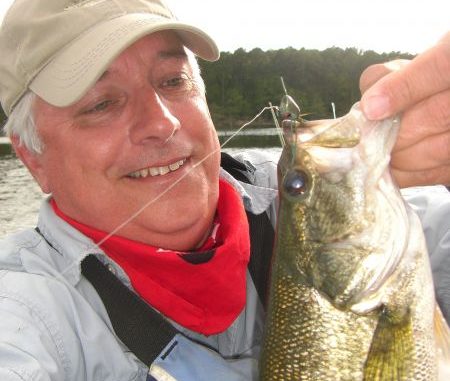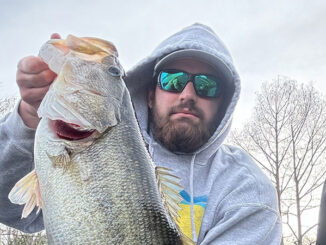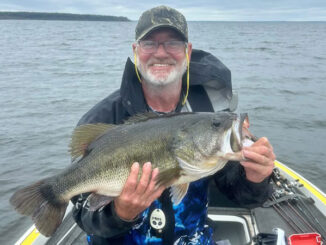
Sprawling Toledo Bend can be a flycaster’s delight
Flyrodders love small waters. I once dug a hole in my backyard that filled with rain, and several of my fly fishing buddies wanted me to stock it.
In a survey conducted on my website several years ago, responders named Pushepataw Creek in St. Tammany as their favorite warm-water location. During a dry spell, and with a gentle breeze to my back, I can spit clear across most sections of “The Push.”
In fact, of the top 10 waters named from that survey, the largest — by far — was 1,000-acre Lake Concordia near Ferriday.
So imagine the response when I suggest to friends a trip to Toledo Bend.
Certain phobias I can understand. Fear of snakes. Fear of heights. Fear of going shopping with your wife. But fear of a lake?
I’ll admit — the Bend is intimidating. It’s big and deep, covering 185,000 acres with an average depth of 54 feet and maximum depth of 110 feet.
For fly anglers, it’s the 800-pound gorilla of freshwater.
Fortunately, my good friend Kevin “Doc” Andry has no fear of big primates. Or big waters.
He inquired if there was any spot we could go, given the summer heat, where we could take our kayaks and still catch plenty bass on the fly.
When I told him Toledo Bend, his reply was, “Let’s do this!”
Any lake 65 miles long and bordering two states will have countless launching options. Doc asked which particular spot we to which we were heading, and in my best pirate’s voice, I gave the answer.
“We’re heading t’ Pirate’s Cove, matey! Thar’s emerald treasure in them waters. Th’ kind that a man o’ th’ fly can appreciate. Th’ fighting kind. Aarrrhhh!”
Many fly anglers think of Toledo Bend as an open body of water. Rather, there are numerous large coves on each side of the main channel. And within those coves, there are numerous smaller coves. And within those smaller coves, even smaller ones.
Better yet, for those of us who enjoy fly fishing from kayaks, nearly all those coves are filled with stumps and grass beds. Natural deterrents to jet skis and ski boats.
The bottom line: There are countless spots where a flycaster can enjoy solace — and good fishing.
The key to successfully fishing the Bend, as with any large expanse of water, is to isolate a particular area, fish it often and learn it well.
My area of choice has been Pirate’s Cove, simply because I like the name. Aarrrhhh!
The scenic drive to Pirate’s Cove from Leesville took us along the Sabine Highlands. East of Highway 171, these are some of the highest elevations in Louisiana. By the time we made this trip, the snowcap had already melted on towering, 490-foot Mount Eagle.
Soon after sunrise, we launched our ’yaks. I tossed a frog-colored popper up against a dock and wham! A 13-inch bass shivered me fly rod.
Meanwhile, Doc also landed a 13-inch bass on a fire-tiger popper in the middle of a deep grass bed.
Besides poppers, best flies for summer fishing include spoonflies, Sqwirms, and the Bass Bully.
In early fall, when the bass start schooling and busting shad in open water, I’ll switch over to a white or gray Deciever, Seaducer, or EP Fly cast on an intermediate sinking line.
Outside of the spawning period, catching big ol’ Toledo bass on the fly is tough. The good news is that what you lose in quality, you’ll make up with numbers of fish up to 4 pounds.
As the morning continued, the strikes from bass decreased and the number of strikes from bluegill increased. Dramatically.
So I switched over to a size 12 beadhead hare’s ear (BHE) set 4 feet below a strike indicator.
This BHE is different than most offerings found in fly shops or catalogs. It’s a Rosborough style (that’s Rosborough with a capital ‘Aarrrhhh’). The collar is tied with a dubbing loop of rabbit fur. The undulating action in water is irresistible to gobbules.
Here’s another acronym — FIG. It stands for “4-inch gobbules.” Regardless of what bream flies you cast on The Bend, you’ll encounter zillions of FIGs. Which can be fun on a 3-weight rod.
To avoid the FIGs, I started casting a large popping bug as a searching pattern. When I caught a keeper bream (7 inches or larger), I switched to the BHE or a Fluff Butt deep under an indicator and proceeded to catch big ones every cast.
By early afternoon, the fish called it quits. And so did we.
No bass over 14 inches, but as we would learn from other anglers, the high pressure had made for a very difficult day for all. At least, I had a nice mess of gobbules to stink up the grease when we got home.
Doc asked when our next trip to The Bend would be. My response?
“I’m ready whenever you aarrrhh!”


